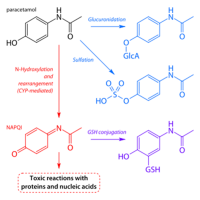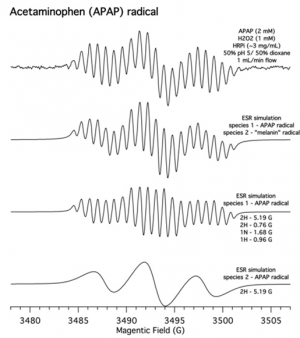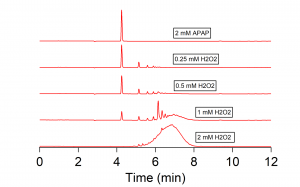Difference between revisions of "Acetaminophen Induced Toxicity"
| Line 26: | Line 26: | ||
==Results== | ==Results== | ||
| − | + | '''Electron Spin Resonance''' | |
| − | + | [[File:APAP_Radical.png|300px|thumb|left|APAP ESR Data (Figure 3)]] | |
| − | [[File:APAP_Radical.png| | ||
Electron Spin Resonance (ESR) experiments indicate the existence of an APAP radical intermediate observable in this HRP mediated reaction. A simulation of this experimental spectrum gave hyperfine coupling values associated with a lone electron being present at the phenoxy, ortho, para, and amide position on the APAP molecule. Background noise was separated out from the APAP radical spectrum, which was referred to as species 2 or melanin. This species had to have hyperfine coupling associated with it in order to simulate experimental data. | Electron Spin Resonance (ESR) experiments indicate the existence of an APAP radical intermediate observable in this HRP mediated reaction. A simulation of this experimental spectrum gave hyperfine coupling values associated with a lone electron being present at the phenoxy, ortho, para, and amide position on the APAP molecule. Background noise was separated out from the APAP radical spectrum, which was referred to as species 2 or melanin. This species had to have hyperfine coupling associated with it in order to simulate experimental data. | ||
| − | + | '''High Performance Liquid Chromatography''' | |
| − | + | [[File:APAP_HPLC.png|300px|thumb|right|APAP/H2O2/HRP Mediated Polymerization (Figure 4)]] | |
| − | |||
| − | |||
| − | |||
| − | |||
| − | |||
| − | |||
| − | |||
| − | |||
| − | |||
| − | |||
| − | |||
| − | |||
| − | |||
| − | |||
| − | |||
| − | |||
| − | |||
| − | |||
| − | |||
| − | |||
| − | |||
| − | |||
| − | |||
| − | |||
| − | |||
| − | |||
| − | |||
| − | |||
| − | |||
| − | |||
| − | |||
| − | |||
| − | |||
| − | |||
| − | |||
| − | |||
==References== | ==References== | ||
Revision as of 20:17, 17 May 2021
One electron oxidation of Acetaminophen
Matthew W. Simonson, William B. Fox, Bradley E. Sturgeon
Monmouth College, Department of Chemistry
Abstract
Acetaminophen (APAP) is a common analgesic and an active ingredient in many painkillers such as Tylenol and Percocet. APAP misuse can lead to Acetaminophen Induced Liver Injury (AILI), which accounts for a striking proportion of acute liver failures in the United States. Better understanding of how APAP toxicity disseminates provides insight into alternative treatments for APAP overdose. Research in our group is focused on investigating the potential one electron oxidation products of the cytochrome P450 (CYP) catalyzed reaction involving APAP under saturated glutathione conditions with the goal of better understanding the pathophysiology behind AILI. This has been investigated by using Horseradish peroxidase (HRP) as an enzyme to model the effects of CYP in order to catalyze the one electron oxidation of APAP with hydrogen peroxide. High Performance Liquid Chromatography (HPLC) was utilized to characterize the oxidation products of this reaction, which resulted in the formation of aqueous insoluble APAP polymers with a reactive radical intermediate as indicated by electron spin resonance (ESR). Further investigation elucidated that the radical reaction could be quenched with ascorbate. Our findings have important implications in understanding the potential one electron oxidation mechanism by which AILI propagates and deals damage within the liver under times of APAP overdose.
Introduction
Seemingly harmless in normal dosages, large quantities of APAP can result in liver necrosis by depleting glutathione reserves in a dose dependent manner (). APAP misuse is responsible for approximately 50% of acute liver failure cases in the United States (). Treatments for Acetaminophen Induced Liver Injury (AILI) are limited and ineffective if not caught early enough. Considering this and the widespread use of APAP containing pharmaceuticals, it is imperative that the mechanism of acetaminophen induced hepatotoxicity be revisited.
The current accepted mechanism by which AILI presents itself is through a two electron oxidation as illustrated in Figure 1. Under normal conditions, APAP is mostly converted to nontoxic metabollites via sulfation or glucuronidation while a small percentage is oxidized by cytochromes P-450 to the proposed two electron oxidation product and highly reactive metabollite, N-acetyl-p-benzoquinone imine (NAPQI) (). NAPQI is suggested to then detoxified through conjugation with glutathione (). During overdose, glucuronidation and sulfation pathways are saturated, thus leading to more NAPQI production. This of course results in the hepatocellular supplies of glutathione becoming stressed as demand for the resource becomes higher than its regeneration (). The purported two electron oxidation product, NAPQI is then suggested to react with cellular membranes and proteins and opens the door to oxidative stress (). In turn, this wreaks havoc and leads to large scale hepatocyte damage and death.
However, this conclusion is not the only explanation, as NAPQI is reported to be rapidly reduced back into APAP in the presence of NADPH and other electron donors (2). There is also evidence for a single electron oxidation characterized by radical APAP intermediates capable of polymerizing. This alternative is overall a less well studied mechanism of toxicity. Such radical APAP intermediates have been shown to be produced in vitro by horseradish peroxidase through electron paramagnetic resonance (). The electron spin density of the previously cited study illustrates four possible radical intermediates capable of polymerizing into various products as shown in Figure 2. The reactivity of the APAP phenoxyl radicals could render this molecule responsible for the effects normally attributed to NAPQI (3). These radical intermediates are capable of dimerizing, trimerizing, and even tetramerizing into insoluble polymers. The insoluble nature of these radically polymerized products have the potential to clump together and precipitate both intracellularly and extracellularly onto cellular structures, thus suggesting a clinically relevant mechanism of damage. Furthermore, identifying these products will elucidate how other biophenols may undergo oxidation to a similar extent.
Materials and Methods
Horseradish Peroxidase (HRP) was isolated and purified from locally grown horseradish root in order to mimic the proposed one electron oxidation of Acetaminophen (APAP) by the liver through Cytochrome P450 3A subfamily (CYP3A) in beaker based conditions. The enzyme was stored at -20 degrees Celsius. Research grade Acetaminophen and 30wt% Hydrogen peroxide was purchased from Sigma Aldridge.
HPLC Analysis
Analysis by reverse phase high pressure liquid chromatography (HPLC) with a C18 column. Analyses were ran for thirty minutes with a mobile phase beginning at 100 percent acidized water to 100 percent 30% volume to volume acetonitrile. UV/Vis spectroscopy was used as a detector for absorbance at 270 nm, APAP's lambda max.
Results
Electron Spin Resonance
Electron Spin Resonance (ESR) experiments indicate the existence of an APAP radical intermediate observable in this HRP mediated reaction. A simulation of this experimental spectrum gave hyperfine coupling values associated with a lone electron being present at the phenoxy, ortho, para, and amide position on the APAP molecule. Background noise was separated out from the APAP radical spectrum, which was referred to as species 2 or melanin. This species had to have hyperfine coupling associated with it in order to simulate experimental data.
High Performance Liquid Chromatography
References
1. Potter, DW; Miller, DW; Hinson, JA. Identification of acetaminophen polymerization products catalyzed by horseradish peroxidase. Journal of Biological Chemistry, 260,22 (1985). 12174-2180. Print
2. Dahlin, DC; Miwa, GT; Lu, AYH; Nelson, SD. N-acetyl-p-benzoquinone imine: a cytochrome P-450-mediated oxidation product of acetaminophen. Journal of Biochemistry, 81 (1984). 1327-1331. Print
3. West, PR; Harman, LS; Josephy, PD; Mason, RP. Acetaminophen: enzymatic formation of a transient phenoxyl free radical. Biochemical Pharmacology, 33(18) (1984) 2933-2936. Print



